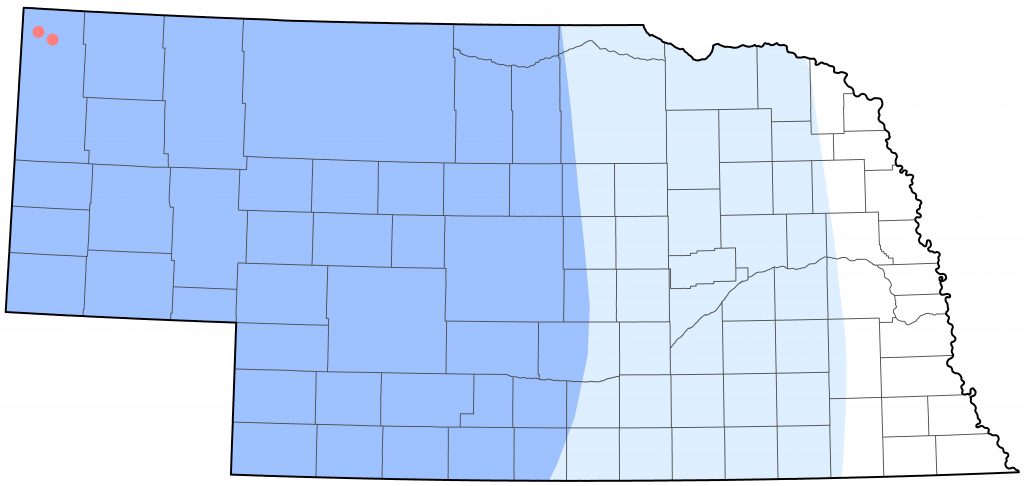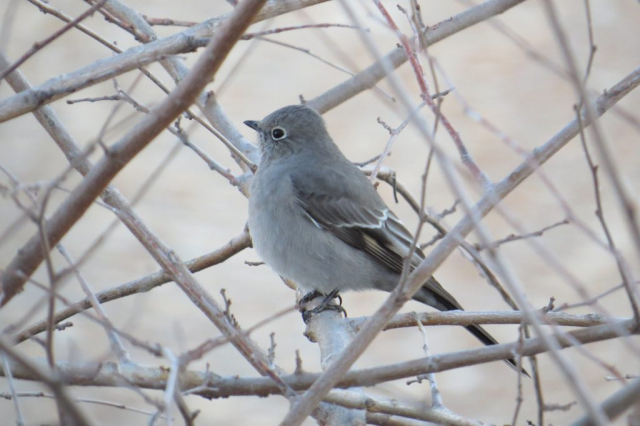Myadestes townsendi townsendi
Status: Rare casual breeder northwest. Common regular winter resident and spring and fall migrant west, uncommon central, rare east.

Documentation: Specimen: UNSM ZM6699, 19 Feb 1896 Harrison, Sioux Co.
Taxonomy: Two subspecies are recognized (AviList 2025) one in Mexico and the other, townsendi, breeding and wintering throughout the North America range.
Nebraska birds are townsendi.
Spring: winter <<<>>> Apr 5, 6, 7 (east), winter <<<>>> May 14, 15, 15 (west and central)
Later reports in the east are 10 Apr 2020 Platte River SP, Cass Co, 10-11 Apr 1997 Douglas Co, 17 Apr 2006 Dakota Co, 17 Apr 2017 Thayer Co, and 24 Apr 2023 Knox Co.
Later reports in the central and west are 19 May 2022 Sioux Co, 22 May 2025 Kimball Co, 25 May 2017 Dawes Co, 30 May 2013 Dawes Co, and 30 May 2025 Chadron SP, Dawes Co (see Summer). An extraordinary late date was of one photographed in Keith Co 8 Jun 2021.
Departure from wintering grounds occurs by late Mar in the east and in the Panhandle by mid-May.
Summer: At the end of the 19th century, this species occurred as a common breeder (Swenk 1919) in northern Sioux Co, occupying the various wooded riparian canyons that drain the Pine Ridge into the Hat Creek Basin (Bruner et al 1904). Two nests were found in Monroe Canyon in 1900, and a pair was seen the next summer (Crawford 1901, Mollhoff 2022). Although it is not clear that significant changes in habitat have occurred, the species now occurs there only casually during the breeding season. It breeds in the Black Hills of South Dakota (Tallman et al 2002) and the Laramie Mountains in southeast Wyoming (Faulkner 2010).
Recent evidence of possible breeding activity in Sioux and Dawes Cos has been inconclusive. In 1986 Rosche found a nest with eggs on 31 May in Hat Creek Canyon, Sioux Co (Williams 1986, Ducey 1988); this nest was unsuccessful (Richard Rosche, personal communication; Sharpe et al 2001). Apart from this report, since 1900 there have been several sightings of adults and flying young, including an adult and a juvenile in Monroe Canyon, Sioux Co 18-20 Jul 1979 (Fickel 1979) and a juvenile seen flying strongly in Sowbelly Canyon, Sioux Co 22 Jul 1980 (Rosche 1982). Rosche (1982) suggested these juveniles were not necessarily fledged in Nebraska, but possibly nearby in the Black Hills of South Dakota. Since then, adults suspected of carrying food were seen at Chadron SP, Dawes Co and in East Monroe Canyon, Sioux Co on separate occasions in recent years; no nests were found despite extensive searches (Wayne Mollhoff, personal communication). A flying juvenile was seen along Pants Butte Road, Sioux Co on 31 Jul 2012, and a single was in Dawes Co 3 Aug 1988.
There are several additional breeding season reports 16 May-2 Aug for Sioux and Dawes Cos without evidence of nesting. Recent sightings include singles 30 May 2013, 30 May 2025, 30 Jun 2009, 11-12 Jun 2019, 13 Jun 1986 all in Dawes Co, and in Sioux Co 19 May 2022, 5-7 Jun 2025 Monroe Canyon, 14 Jun 2014 (Bird Conservancy of the Rockies), one photographed at Ponderosa WMA, Dawes Co 16 Jun 2019, one in Scotts Bluff Co 23 Jun 2022 (Daniel Horton, personal communication), and one at NNF Halsey, Thomas Co 18 Jun 2014.
Further east, one at Metcalf WMA, Sheridan Co 12 Jun 2011 may have been breeding or merely a very late migrant; another was one heard on a Western Wood-Pewee recording at NNF Halsey 18 Jun 2016 (Robbins, eBird.org). Rosche (1994) cited a report (Benckeser 1948) of an adult and a young bird in cedars east of Ogallala, Keith Co 18 Jul 1948, and suggested that an occasional nesting attempt in the area “would not be too surprising.”
Fall: Sep 13, 13, 14 <<<>>> winter (west and central), Dec 14, 14, 14 <<<>>> winter (east)
Earlier dates in the west and central are 7 Aug 2020 Keith Co (recording, eBird.org), 15 Aug 1989 Sioux Co, 25 Aug 2019 Sioux Co, 30 Aug 2003 Sioux Co, 31 Aug 2020 Kimball Co, 31 Aug 2021 Oliver Reservoir, Kimball Co, 1 Sep 2021 Gilbert-Baker WMA, Sioux Co, 3 Sep 2017 Dawes Co, 4 Sep 2014 Sioux Co, 9 Sep 2018 Sheridan Co, and 11 Sep 2023 Kimball Co.
Earlier dates in the east are 16 Oct 2017 Dixon Co, 24 Oct 2006 Cedar Co, 25 Oct 2014 Lancaster Co, 4 Nov 2007 Hamilton Co, one photographed 5 Nov 2017 Lancaster Co, 13-15 Nov 2019 Lancaster Co, 17 Nov 2024 Antelope Co, 18 Nov 1984 Wayne Co.
Solitaires arrive in the Panhandle in Sep, reaching the east in low numbers most years by late Nov-Dec.
Winter: CBC data show that highest densities of wintering solitaires occur in the Panhandle, with lower densities occurring throughout the rest of the state, declining sharply eastward. Wintering birds are mostly, if not all, altitudinal migrants, presumably from South Dakota and Wyoming, which accounts for the variability of wintering numbers resulting from varying severity of winter weather. Winter 2015-2016 was a low numbers year for this species; the Scottsbluff CBC 19 Dec found only one, and only 24 (14 of these at Lake McConaughy, Keith Co) were found on all 2015-2016 CBCs, none east of North Platte, Lincoln Co.
This species wintered “eastward over the entire state” around 1900 (Bruner et al 1904), a status which is unchanged to the present, although solitaires are rare in the east. Pooled statewide CBC data show an increase in birds per party-hour beginning in the early 1990s.
- High counts: 157 on the Lake McConaughy CBC 2 Jan 2006, 94 on that CBC 29 Dec 2007, 50+ in southeast Lincoln Co 29 Dec 2003, and 33 at Cedar Canyon WMA, Scotts Bluff Co 9 Feb 2022.
Images
Abbreviations
CBC: Christmas Bird Count
NNF: Nebraska National Forest
SP: State Park
UNSM: University of Nebraska State Museum
WMA: Wildlife Management Area (State)
Literature Cited
AviList Core Team, 2025. AviList: The Global Avian Checklist, v2025. https://doi.org/10.2173/avilist.v2025.
Benckeser, H.R. 1948. News from Brule. NBR 16: 94-96.
Bruner, L., R.H. Wolcott, and M.H. Swenk. 1904. A preliminary review of the birds of Nebraska, with synopses. Klopp and Bartlett, Omaha, Nebraska, USA.
Crawford, J.C., Jr. 1901. Results of a collecting trip to Sioux County. Proceeding of the Nebraska Ornithologists’ Union 2: 76-79.
Ducey, J.E. 1988. Nebraska birds, breeding status and distribution. Simmons-Boardman Books, Omaha, Nebraska, USA.
Faulkner, D.W. 2010. Birds of Wyoming. Roberts and Company, Greenwood Village, Colorado, USA.
Fickel, T. 1979. Townsend’s Solitaires in Sioux County, Nebraska. NBR 47: 68-69.
Mollhoff, W.J. 2022. Nest records of Nebraska birds. Nebraska Ornithologists’ Union Occasional Paper Number 9.
Rosche, R.C. 1982. Birds of northwestern Nebraska and southwestern South Dakota, an annotated checklist. Cottonwood Press, Crawford, Nebraska, USA.
Rosche, R.C. 1994. Birds of the Lake McConaughy area and the North Platte River valley, Nebraska. Published by the author, Chadron, Nebraska, USA.
Sharpe, R.S., W.R. Silcock, and J.G. Jorgensen. 2001. The birds of Nebraska: their distribution and temporal occurrence. University of Nebraska Press, Lincoln, Nebraska.
Swenk, M.H. 1919. The Birds and Mammals of Nebraska. Contributions of the Department of Entomology No. 23. Lincoln, Nebraska.
Tallman, D.A., Swanson, D.L., and J.S. Palmer. 2002. Birds of South Dakota. Midstates/Quality Quick Print, Aberdeen, South Dakota, USA.
Williams, F. 1986. Southern Great Plains Region. American Birds 40: 491-494.
Recommended Citation
Silcock, W.R., and J.G. Jorgensen. 2025. Townsend’s Solitaire (Myadestes townsendi). In Birds of Nebraska — Online. www.BirdsofNebraska.org
Birds of Nebraska – Online
Updated 28 Aug 2025

